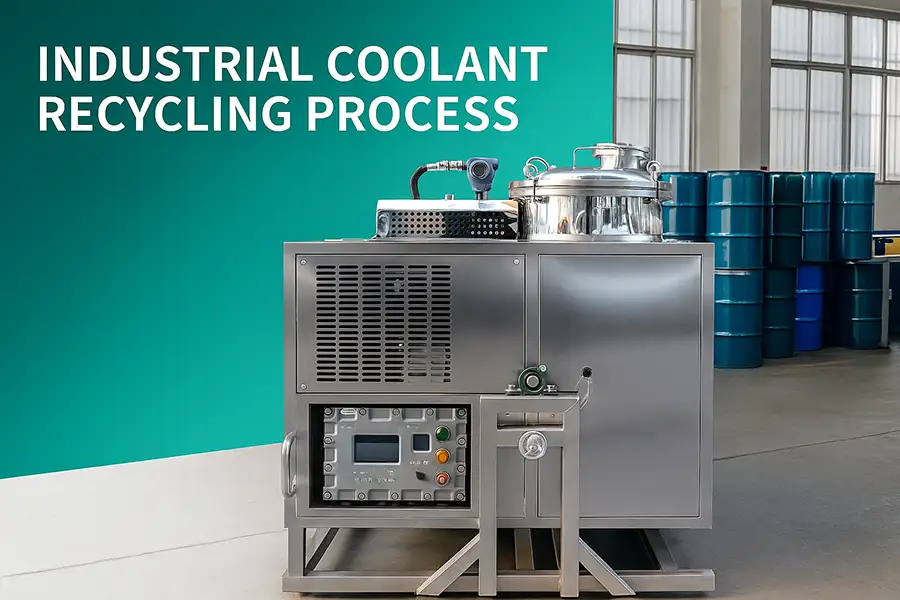Coolant Recycling: Protecting the Planet and Your Bottom Line
Discover how modern solvent recycling machines make coolant recovery efficient, safe, and cost-effective for businesses of all sizes
What is Coolant Recycling?
Coolant recycling is the process of cleaning and reusing industrial coolants, such as those used in machining, automotive, and manufacturing processes. Over time, coolants become contaminated with oils, metal particles, and other impurities. Instead of disposing of these fluids—which can be harmful to the environment—companies can recycle them using advanced solvent recycler machines.
Recycling coolants not only reduces hazardous waste but also saves money by minimizing the need to purchase new fluids. In industries with high coolant usage, this can translate into thousands of dollars in annual savings.
Industrial plants save an average of 60% in coolant costs through recycling programs.

Why Coolant Recycling Matters

According to the U.S. Environmental Protection Agency (EPA), millions of gallons of used coolant are discarded every year, often ending up in landfills or waterways. This poses a significant threat to ecosystems and public health.
From an economic standpoint, recycling allows companies to recover valuable materials and reduce disposal fees. The process also aligns with corporate sustainability goals, which are becoming increasingly important in competitive markets.
Did you know?
According to a Massachusetts Institute of Technology (MIT) study, AI and automation are expected to replace 30% of jobs by 2030. This means industries must adapt by integrating smart, efficient technologies—including automated coolant recycling systems—to remain competitive.
How Does a Solvent Recycler Machine Work?
A solvent recycler machine uses distillation or filtration to separate contaminants from the coolant. The clean fluid is then returned for reuse, while the waste is collected for proper disposal. This process is straightforward, safe, and can be automated for continuous operation.
What happens if contaminated coolant is disposed of without treatment?
Answer: It can leach toxic metals and chemicals into soil and water, harming wildlife and potentially contaminating drinking water sources. Additionally, improper disposal can lead to regulatory fines.

The Recycling Process in 5 Steps:
Collection of Used Coolant
Contaminated coolant is safely collected from manufacturing processes and stored in dedicated containers.
Filtration Pre-treatment
Initial filtration removes large particles, solids, and debris from the coolant mixture.
Distillation Process
The coolant is heated to vaporize it in a closed system, then condensed back into pure liquid form.
Separation & Clarification
Impurities and oils are separated from the coolant, resulting in clean recycled fluid.
Reutilization
The recycled coolant is returned to production processes with performance equivalent to new coolant.
Key Benefits of Coolant Recycling
Significant Cost Savings
Reduce coolant purchase costs by 40-60%. Lower waste disposal expenses and minimize operational downtime for fluid replacement.
Environmental Compliance
Meet EPA regulations and avoid costly fines. Demonstrate environmental responsibility to customers and stakeholders.
Machinery Protection
Cleaner coolant extends equipment life and reduces maintenance costs, preventing corrosion and damage to critical components.
Enhanced Performance
High-quality recycled coolant provides consistent performance and improves machining precision.
Can recycled coolant perform as well as new coolant?
Answer: Yes! When processed through a high-quality solvent recycling system, regenerated coolant can meet or exceed the performance of new fluid, ensuring optimal machinery operation.
Quantifiable Cost Savings
The table below demonstrates the potential cost savings achievable through implementing a coolant recycling program. Actual savings vary based on industry, coolant type, and production volumes.
| Usage Scenario | Annual Coolant Purchase Cost | Annual Cost with Recycling | Annual Savings | ROI Period |
|---|---|---|---|---|
| Small Workshop | $5,000 | $2,000 | $3,000 | |
| Mid-size Factory | $25,000 | $10,000 | $15,000 | 6-9 months |
| Large Industrial Plant | $100,000 | $40,000 | $60,000 | 4-7 months |
| Mega Manufacturing Complex | $480,000 | $192,000 | $288,000 | 3-5 months |
*Savings based on average coolant recovery rates of 80-85% and equipment costs of $3,000–$15,000 depending on system size.
Coolant Recycling Applications
Many manufacturing plants have adopted closed-loop recycling systems. These systems continuously filter and refresh coolant, drastically reducing waste output. Automotive workshops also benefit by recycling antifreeze, cutting costs and reducing environmental impact.
Automotive & Transportation
Recycling fluids used in machining engine parts, gear manufacturing, and radiator coolant maintenance.
Industrial Manufacturing
Coolant recovery in CNC machining centers, grinding operations, and metal stamping facilities.
Electronics & Aerospace
Precision recycling for specialized cutting fluids used in critical components manufacturing.

Ready to Reduce Your Costs & Environmental Impact?
Discover how our solvent recycler machines can transform your industrial processes.
